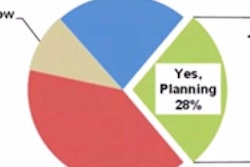
The use of CT has increased over the past 15 years faster than other forms of imaging, leading to concerns about overuse and radiation exposure. But since 2009, CT's growth rate has slowed among privately insured patients, according to a study in the February issue of the Journal of the American College of Radiology.
Researchers found that after years of rapid growth, CT use dropped among nearly all age groups from 2009 to 2011 -- a sign, perhaps, that initiatives such as Image Gently and reimbursement cuts are affecting utilization. In particular, children younger than 10 have seen double-digit declines in CT use, according to the group from the University of North Carolina at Chapel Hill and the International Agency for Research on Cancer in Lyon, France.
But over the longer period of 2000 to 2011, CT use grew sharply among all categories except for infants, even at triple-digit growth rates among men and women ages 18 to 24. The findings underscore recent concerns about radiation dose and cancer, such as those expressed in an op-ed article last week in the New York Times.
A different picture of CT
A number of recent studies have investigated overall increases or decreases in CT use. But when data are analyzed by body region and age, a different picture emerges -- one that may help to clarify CT's benefits versus its risks.
 Dr. Richard Semelka from the University of North Carolina.
Dr. Richard Semelka from the University of North Carolina."Numerous studies have shown a significant increase in the use of CT, although that increase has slowed," contributing author Dr. Richard Semelka told AuntMinnie.com. "To really understand CT use patterns, we wanted to separate the data more distinctly, looking at different age groups and indications."
Semelka and colleagues examined trends in the use of diagnostic CT overall and for four major body regions: abdomen/pelvis, head/neck, chest, and spine. The group used data from 2000 to 2011 from the MarketScan Research Databases from Thomson Healthcare, which tracks insurance plan information and claims for more than 100 million Americans with private, employer-based insurance.
For the study, Semelka and colleagues only included procedures for which CT was the exclusive imaging source; PET/CT exams were excluded. They separated patients by gender and into nine separate age categories, from infants to those older than 65 (JACR, February 2014, Vol. 11:2, pp. 125-130).
The group found that 35.6 million diagnostic CT scans were performed between 2000 and 2011, with the four major body regions accounting for 97% of these scans. Of the four regions, head/neck CTs accounted for 32.6% of the total scans performed during the time frame, abdomen/pelvis CT scans accounted for 38.6%, chest CTs accounted for 21.1%, and spine CT scans accounted for 4.8%.
Elderly patients (65 and older) experienced the largest absolute increase in scans used. The percentage change from 2000 to 2011 when evaluated by gender was 72% and 87% for men and women 65 and older, respectively; for men and women ages 18 to 24, the percentage change was 135% and 129%.
| Change in rates of diagnostic CT scans from 2000 to 2011, women | |||||
| Age group | All | Head/neck | Chest | Abdomen/pelvis | Spine |
| < 1 | -3% | -2% | 367% | -41% | 47% |
| 1-9 | 19% | 1% | 63% | 96% | 262% |
| 10-17 | 81% | 39% | 138% | 154% | 258% |
| 18-24 | 129% | 50% | 283% | 240% | 339% |
| 25-34 | 102% | 37% | 217% | 180% | 120% |
| 35-44 | 89% | 44% | 165% | 134% | 56% |
| 45-54 | 66% | 39% | 116% | 89% | 45% |
| 55-64 | 44% | 28% | 75% | 51% | 35% |
| 65+ | 87% | 65% | 138% | 71% | 215% |
| Change in rates of diagnostic CT scans from 2000 to 2011, men | |||||
| Age group | All | Head/neck | Chest | Abdomen/pelvis | Spine |
| < 1 | -4% | -15% | 66% | -14% | 30% |
| 1-9 | 14% | -2% | 48% | 78% | 211% |
| 10-17 | 58% | 37% | 91% | 81% | 194% |
| 18-24 | 135% | 88% | 161% | 197% | 321% |
| 25-34 | 87% | 44% | 108% | 146% | 96% |
| 35-44 | 86% | 41% | 116% | 136% | 56% |
| 45-54 | 63% | 35% | 88% | 82% | 49% |
| 55-64 | 52% | 30% | 70% | 62% | 58% |
| 65+ | 72% | 56% | 101% | 69% | 141% |
From 2009 to 2011 -- after both the Deficit Reduction Act (DRA) and the Image Gently campaign went into effect -- most age groups experienced a modest to substantial decrease in the use of diagnostic CT (3% to 9%), with children younger than 1 year experiencing a decrease of 17%, and children 1 to 9 experiencing a decrease of 25%, the authors wrote.
The exception? Patients 65 and older and men between the ages of 18 and 24 experienced little to no change during the study period.
Although spine CT scans were used at a lower rate than abdominal/pelvic, head/neck, and chest scans, the use of this exam increased beyond the other three body regions and across most age and gender groups between 2000 and 2011, the team found.
Like other research, the study shows macro changes in the overall use of CT, according to Semelka and colleagues. But it also shows that it's critical to understand differences in rates of change by gender, age, and body region so that both the public and physicians can make better imaging decisions.
"It's a good thing that overall CT use has been reduced; physicians are beginning to grasp that medical radiation needs to be used carefully," Semelka said. "But it's important to make sure patients are still getting the imaging they need."



















